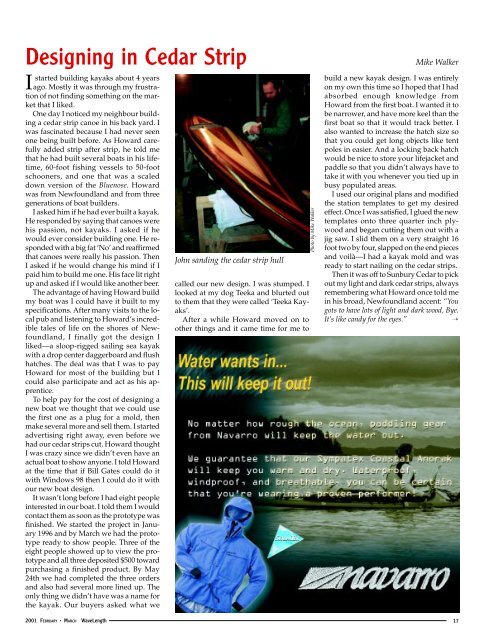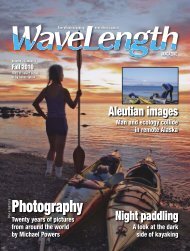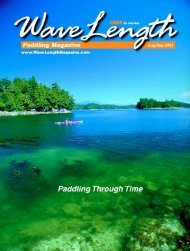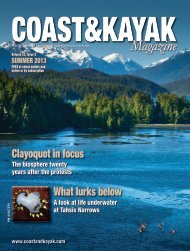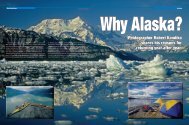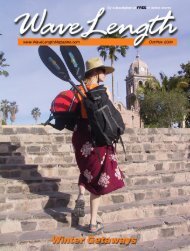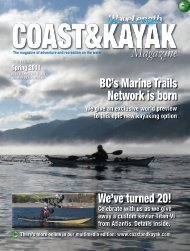Alexandra - Wavelength Paddling Magazine
Alexandra - Wavelength Paddling Magazine
Alexandra - Wavelength Paddling Magazine
You also want an ePaper? Increase the reach of your titles
YUMPU automatically turns print PDFs into web optimized ePapers that Google loves.
Designing in Cedar Strip Mike Walker<br />
I<br />
started building kayaks about 4 years<br />
ago. Mostly it was through my frustration<br />
of not finding something on the market<br />
that I liked.<br />
One day I noticed my neighbour building<br />
a cedar strip canoe in his back yard. I<br />
was fascinated because I had never seen<br />
one being built before. As Howard carefully<br />
added strip after strip, he told me<br />
that he had built several boats in his lifetime,<br />
60-foot fishing vessels to 50-foot<br />
schooners, and one that was a scaled<br />
down version of the Bluenose. Howard<br />
was from Newfoundland and from three<br />
generations of boat builders.<br />
I asked him if he had ever built a kayak.<br />
He responded by saying that canoes were<br />
his passion, not kayaks. I asked if he<br />
would ever consider building one. He responded<br />
with a big fat ‘No’ and reaffirmed<br />
that canoes were really his passion. Then<br />
I asked if he would change his mind if I<br />
paid him to build me one. His face lit right<br />
up and asked if I would like another beer.<br />
The advantage of having Howard build<br />
my boat was I could have it built to my<br />
specifications. After many visits to the local<br />
pub and listening to Howard’s incredible<br />
tales of life on the shores of Newfoundland,<br />
I finally got the design I<br />
liked—a sloop-rigged sailing sea kayak<br />
with a drop center daggerboard and flush<br />
hatches. The deal was that I was to pay<br />
Howard for most of the building but I<br />
could also participate and act as his apprentice.<br />
To help pay for the cost of designing a<br />
new boat we thought that we could use<br />
the first one as a plug for a mold, then<br />
make several more and sell them. I started<br />
advertising right away, even before we<br />
had our cedar strips cut. Howard thought<br />
I was crazy since we didn’t even have an<br />
actual boat to show anyone. I told Howard<br />
at the time that if Bill Gates could do it<br />
with Windows 98 then I could do it with<br />
our new boat design.<br />
It wasn’t long before I had eight people<br />
interested in our boat. I told them I would<br />
contact them as soon as the prototype was<br />
finished. We started the project in January<br />
1996 and by March we had the prototype<br />
ready to show people. Three of the<br />
eight people showed up to view the prototype<br />
and all three deposited $500 toward<br />
purchasing a finished product. By May<br />
24th we had completed the three orders<br />
and also had several more lined up. The<br />
only thing we didn’t have was a name for<br />
the kayak. Our buyers asked what we<br />
2001 FEBRUARY • MARCH WaveLength<br />
John sanding the cedar strip hull<br />
called our new design. I was stumped. I<br />
looked at my dog Teeka and blurted out<br />
to them that they were called ‘Teeka Kayaks’.<br />
After a while Howard moved on to<br />
other things and it came time for me to<br />
Photo by Mike Walker<br />
build a new kayak design. I was entirely<br />
on my own this time so I hoped that I had<br />
absorbed enough knowledge from<br />
Howard from the first boat. I wanted it to<br />
be narrower, and have more keel than the<br />
first boat so that it would track better. I<br />
also wanted to increase the hatch size so<br />
that you could get long objects like tent<br />
poles in easier. And a locking back hatch<br />
would be nice to store your lifejacket and<br />
paddle so that you didn’t always have to<br />
take it with you whenever you tied up in<br />
busy populated areas.<br />
I used our original plans and modified<br />
the station templates to get my desired<br />
effect. Once I was satisfied, I glued the new<br />
templates onto three quarter inch plywood<br />
and began cutting them out with a<br />
jig saw. I slid them on a very straight 16<br />
foot two by four, slapped on the end pieces<br />
and voilà—I had a kayak mold and was<br />
ready to start nailing on the cedar strips.<br />
Then it was off to Sunbury Cedar to pick<br />
out my light and dark cedar strips, always<br />
remembering what Howard once told me<br />
in his broad, Newfoundland accent: “You<br />
gots to have lots of light and dark wood, Bye.<br />
It’s like candy for the eyes.”<br />
→<br />
17


